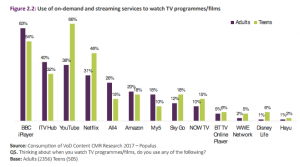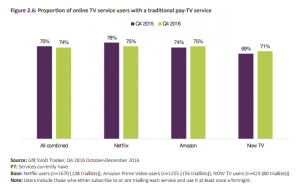
After more than 40 years of operation, DTVE is closing its doors and our website will no longer be updated daily. Thank you for all of your support.
Ofcom report shines light on UK binge viewing habits
 The UK has become “a nation of binge viewers” but there are stark differences between how older and younger people watch TV, according to Ofcom.
The UK has become “a nation of binge viewers” but there are stark differences between how older and younger people watch TV, according to Ofcom.
The UK broadcast regulator’s annual Communications Market Report 2017 claims that 79% of UK adults, some 40 million people, now use catch-up services like the BBC iPlayer, or subscription services like Netflix, to watch multiple episodes of a series in one sitting.
Bingeing was found to be most popular among young people, with some 53% of 12-15 year-olds viewing in this way on a weekly basis, compared to just 16% of people aged over 65.
Ofcom said that time spent watching broadcast TV continued to decline in 2016, though to a lesser extent than in previous years. Viewers spent an average of 3 hours 32 minutes a day watching broadcast television on TV sets in 2016, down just four minutes compared to 2015.
However, within this there is a “widening gap” between the viewing activities of the youngest and oldest audiences, with the steepest decline in broadcast TV viewing found among 4-15 year-olds and 16-24s.
Young people aged 16-24 watched an average of 1 hour 54 minutes of broadcast TV a day in 2016, a 41-minute decline compared to 2006. However viewers aged over 64 watched an average of 5 hours 44 minutes a day in 2016, up 50 minutes over the same 10-year period.
 Overall, 76% of people aged 16-24 were found to use a subscription streaming service like Netflix or Amazon Prime, compared to 19% of people aged over 65.
Overall, 76% of people aged 16-24 were found to use a subscription streaming service like Netflix or Amazon Prime, compared to 19% of people aged over 65.
Among all UK adults, the BBC iPlayer was the most popular on-demand service with 63% saying they use it, followed by ITV Hub at 40%, YouTube at 38% and Netflix at 31%.
“Technology has revolutionised the way we watch TV,” said Ofcom’s consumer group director, Lindsey Fussell. “The days of waiting a week for the next episode are largely gone, with people finding it hard to resist watching multiple episodes around the house or on the move.”
“But live television still has a special draw, and the power to bring the whole family together in a common experience.”
Ofcom said that the UK’s pay TV platform operators – Sky, Virgin Media, BT and TalkTalk – generated 46% of total industry revenue last year at £6.4 billion – up 3% year-on-year in real terms.
By contrast commercial public service broadcast channels’ revenue has declined at an average rate of 2% per year in real terms and came to £2.4 billion in 2016. Revenue for commercial multi-channels was £2.5bn in 2016, having grown at an average of 5% each year since 2011.
 On-demand and streaming services like Netflix, Amazon Prime and Now TV were found to be “mainly complementary” to traditional pay TV platforms with 74% of subscribers to these services also taking a pay TV subscription.
On-demand and streaming services like Netflix, Amazon Prime and Now TV were found to be “mainly complementary” to traditional pay TV platforms with 74% of subscribers to these services also taking a pay TV subscription.
Commenting on the research, Stephen van Rooyen, CEO, Sky UK and Ireland, said: “This year we have seen Sky customers binge-watch like never before, including 17m downloads of our record-breaking Sky Original Riviera. There have been almost 40m downloads and streams of Series 1-6 of Game of Thrones across Sky and Now TV in the past three months alone as viewers race through back-to-back box sets”.
Dan Howdle, consumer telecoms analyst at Cable.co.uk, said: “The findings clearly demonstrate a preference by the British public that’s shifting away from traditional live television. More and more, people are choosing to fire up their favourite shows and watch them back to back rather than just sitting down and ‘seeing what’s on’.”
Ofcom’s full Communications Market Report 2017 can be accessed here.


